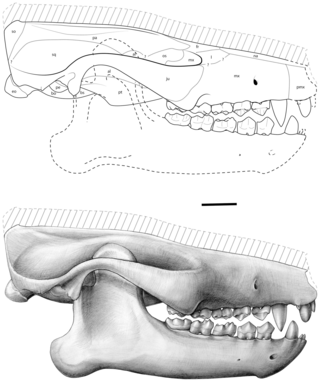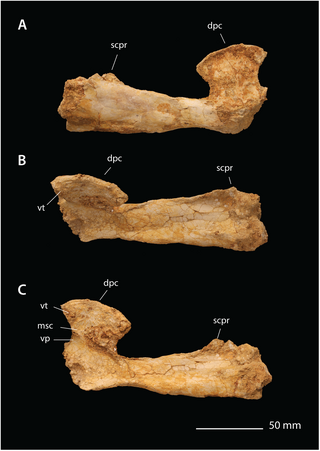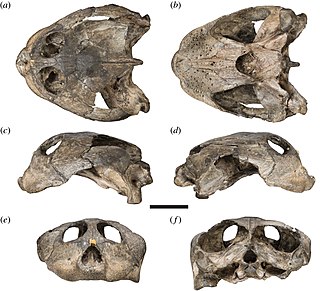
Dermochelyidae is a family of turtles which has seven extinct genera and one extant genus, including the largest living sea turtles.

Daouitherium is an extinct genus of early proboscideans that lived during the early Eocene some 55 million years ago in North Africa.

Bothremydidae is an extinct family of side-necked turtles (Pleurodira) known from the Cretaceous and Cenozoic. They are closely related to Podocnemididae, and are amongst the most widely distributed pleurodire groups, with their fossils having been found in Africa, India, the Middle East, Europe, North America and South America. Bothremydids were aquatic turtles with a high morphological diversity, indicative of generalist, molluscivorous, piscivorous and possibly herbivorous grazing diets, with some probably capable of suction feeding. Unlike modern pleurodires, which are exclusively freshwater, bothremydids inhabited freshwater, marine and coastal environments. Their marine habits allowed bothremydids to disperse across oceanic barriers into Europe and North America during the early Late Cretaceous (Cenomanian). The youngest records of the group are indeterminate remains from Saudi Arabia and Oman, dating to the Miocene.
Corsochelys is an extinct genus of sea turtle that lived in the Late Cretaceous (Campanian). Zangerl (1960) named the type species, based upon remains found in Alabama within the Mooreville Chalk Formation.

Argillochelys is an extinct genus of sea turtle from the middle to lower Eocene in what is now the island of Great Britain. It was first named by Lydekker in 1889.

Pancheloniidae is a clade of sea turtles It is defined as all turtles more closely related to cheloniid sea turtles than to dermochelyid ("leatherback") sea turtles.

Ocepeia is an extinct genus of afrotherian mammal that lived in present-day Morocco during the middle Paleocene epoch, approximately 60 million years ago. First named and described in 2001, the type species is O. daouiensis from the Selandian stage of Morocco's Ouled Abdoun Basin. A second, larger species, O. grandis, is known from the Thanetian, a slightly younger stage in the same area. In life, the two species are estimated to have weighed about 3.5 kg (7.7 lb) and 10 kg (22 lb), respectively, and are believed to have been specialized leaf-eaters. The fossil skulls of Ocepeia are the oldest known afrotherian skulls, and the best-known of any Paleocene mammal in Africa.

The Oulad Abdoun Basin is a phosphate sedimentary basin located in Morocco, near the city of Khouribga. It is the largest in Morocco, comprising 44% of Morocco's phosphate reserves, and at least 26.8 billion tons of phosphate. It is also known as an important site for vertebrate fossils, with deposits ranging from the Late Cretaceous (Cenomanian-Turonian) to the Eocene epoch (Ypresian), a period of about 25 million years.

Abdounodus is an extinct genus of mammal known from the middle Paleocene of northern Africa. The sole species, A. hamdii, is known from teeth discovered in the Ouled Abdoun Basin of present-day Morocco in 2001. Traditionally considered a mioclaenid "condylarth", recent studies place it as a basal afrothere closely related to Ocepeia, demonstrating the close convergent evolution between perissodactyls and herbivorous afrotheres and bridging paenungulates with other afrotheres.

Alcione is a genus of pterosaur from the Ouled Abdoun Basin of Morocco, dating back to the Maastrichtian stage of the Late Cretaceous period. Only one species, A. elainus, is known. This pterosaur lived in a marine environment alongside several other pterosaurs, including Simurghia and Barbaridactylus.

Barbaridactylus is a nyctosaurid pterosaur from the Ouled Abdoun Basin of Morocco, a basin that dates back to the Maastrichtian stage of the Late Cretaceous. It was published in 2018 by paleontologists Nicholas R. Longrich, David M. Martill, and Brian Andres. In the same publication, two other pterosaurs from the same basin were described: Alcione and Simurghia. The type and only species is B. grandis.

Simurghia is a genus of pterosaur from the Ouled Abdoun Basin of Morocco, a basin that dates to the Maastrichtian stage of the Late Cretaceous period, about 66 million years ago. It was published in 2018 by paleontologists Nicholas R. Longrich, David M. Martill, and Brian Andres, along with two other pterosaurs from the same basin: Alcione and Barbaridactylus. The type and only species is S. robusta.

Sandownidae is a family of extinct marine turtles from the Cretaceous and Paleogene distributed around the Atlantic Ocean and adjacent areas. The family is defined as all taxa closer to the type genus Sandownia than to Pelomedusa, Testudo, Solnhofia, Eurysternum, Plesiochelys, Thalassemys or Protostega, a definition that encompasses the previous concept of the clade while also excluding it from being synonymous with other clades of modern or extinct marine turtles. Sandownidae may be within the larger clade Angolachelonia, defined as inclusive of Angolachelys and Solnhofia, sister to the entirely Late Jurassic marine group Thalassochelydia, although the concepts of the clades may shift with further phylogenetic analysis.
Arechia is an extinct genus of stingaree from the Eocene epoch. It is the oldest known stingaree genus, though molecular data suggests they diverged from Butterfly rays about 75 million years ago or from Deepwater stingrays around the time of the K-Pg transition. The type species, A. arambourgi, is known from isolated teeth found in the Ypresian deposits of Ouled Abdoun, Morocco. It is named for Camille Arambourg, who originally ascribed these teeth to Raja praealba in 1952. Henri Cappetta revised the species in 1983, erecting this genus for those Arambourg called males in this genus and placed the ones he called females in Merabatis. The second species, A. crassicaudata is from the Ypresian-age Bolca Lagerstätte of Italy and is known from several articulated individuals. This species was described in 1818 and was placed in various genera until finally being attributed to this one in 2020. The inferred environment of the Monte Postale site where this species is found matches with the typical warm, shallow environment of extant representatives of this family.

Glossochelys is an extinct genus of sea turtles from the Pancheloniidae that has been discovered in Eocene (Ypresian) deposits in Harwich, England that was first described as a species of Lytoloma in 1842. The type species, G. planimentum, was described as a separate species in 1871 by Harry Seeley. It was possibly the same animal as Euclastes or Erquelinnesia.
Araiochelys is an extinct genus of bothremydid pleurodiran turtle that was discovered in the Ouled Abdoun Basin, Morocco. The genus consists solely of type species A. hirayamai.
Elochelys is an extinct genus of bothremydid pleurodiran turtle that was discovered in the Campanian of Fuveau Basin, France. The genus consists solely of type species E. perfecta, though a second species was reassigned to the genus Iberoccitanemys.
Phosphatochelys is an extinct genus of bothremydid pleurodiran turtle that was discovered near Oued Zem, Morocco. The genus consists solely of type species P. tedfordi.
Rhothonemys is an extinct genus of bothremydid pleurodiran turtle that was discovered in the Paleogene of Morocco. The genus consists solely of type species R. brinkmani.
Ummulisani is an extinct genus of bothremydid pleurodiran turtle that was discovered in the Eocene of Morocco. The genus consists solely of type species U. rutgersensis.












